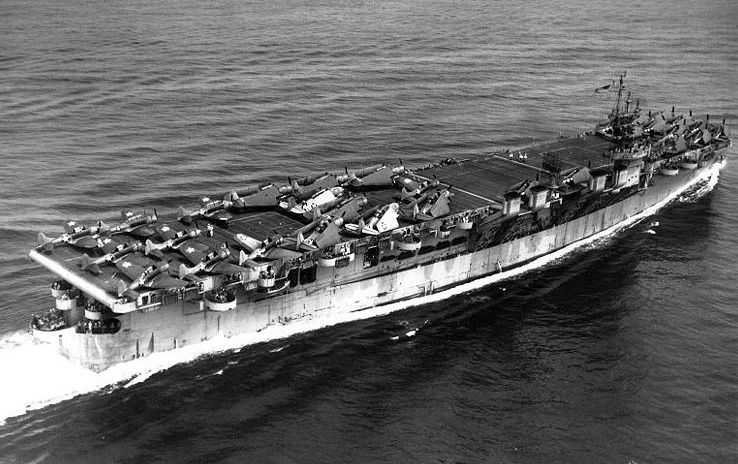18 October 1943: Abbot and Cowpens (CVL 25) collide
Abbot collided with the Independence-class aircraft carrier Cowpens during training off Hawaii at 2:24 a.m. on 18 October 1943. It was the costliest day in Abbot’s history, leaving three dead, several men severely injured and Abbot’s bow bent to a severe 75° angle.
A simple miscommunication caused the disaster; a vague order to the task group led to a change of course that caused Abbot to strike Cowpens as they were both turning left in the dark. At 622½ feet (190 meters) long and displacing 11,000 tons, Cowpens was nearly twice the length of Abbot, and five times heavier. It was as if Abbot had struck a concrete wall.
Abbot’s forward crew berths were crushed, killing three men in their bunks and severely injuring six others. Several more men were trapped. The dead Abbot sailors were Seaman 2nd Class Frederic Louis Nedeau, Boatswain’s Mate 1st Class Edward James Halligan and Gunner’s Mate 2nd Class Arthur Walter Ceresna.
(Seaman Nedeau lies in Honolulu, at the National Memorial Cemetery of the Pacific; in 1947, Petty Officer Ceresna was buried in Long Island National Cemetery, New York, and Petty Officer Halligan was buried in Arlington National Cemetery.)
In the chaotic minutes after the collision, Abbot’s crew shored up the damaged section and rigged pumps to drain several flooded compartments. At 10:47 a.m. a fire broke out but was quickly extinguished, and the immediate crisis ended.
Abbot, escorted by the Benson-class destroyer Coghlan, slowly steamed into Pearl Harbor at noon the next day and was back at sea for post-repair trials on 10 December 1943. The Abboteers rejoined the fleet a few days later, sailing to Funafuti, Ellice Islands.
Damage to Cowpens’ starboard stern was light — its rudder was jammed full right — and there was one minor injury. The photo at lower right shows Cowpens from the starboard stern, with the site of the collision on the left of the picture. Cowpens, known as The Mighty Moo, was back in action within a few weeks.
See the action report for exact details of the events leading to the collision. Also, see the still photos and recollections of Charlie Angevine.
Film

The film shows Abbot arriving in Pearl Harbor on the afternoon of 19 October 1943, close-ups of the damage and brief views of other nearby Fletcher-class destroyers from DesDiv 48. Some of it was apparently filmed from a lighter or dinghy shortly after Abbot arrived.
This two-minute clip is from a duplicate 16mm film that was copied from the original in the 1950s. The dirt and scratches were on the original film and were copied to the duplicate. Also, the duplicate was not a precision copy of the original, so there is some jerkiness and misalignment.
The original film was in the possession of a former crew member of the destroyer Kidd. As part of the same destroyer squadron, Kidd would have frequently been in the vicinity of Abbot. The original film contains nearly 17 additional minutes of scenes of destroyer life, but only the Abbot footage is shown here; the balance of film can be viewed separately.
The original film is believed to have been lost in a fire shortly after the duplicate was made. If so, the chances of finding a better duplicate are practically nil.
Sound Clip
To hear a U.S. Navy collision alarm from the 1940s, use the controller above; if the controller isn’t visible, click to hear the sound clip. This sound clip is from the excellent Historic Naval Ships Association web site.
The first sound is a collision Klaxon, a type of motor-powered siren used to alert the crew to brace for an imminent collision; the second sound is a boatswain’s call; next is a bugle call, used on larger ships; and finally the general alarm, which was also used for calling battle stations.